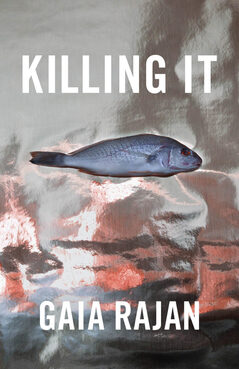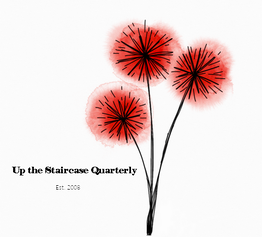Killing It by Gaia Rajan
Review by R. Thursday.
It took me far too long to write this review. It’s not my fault: every time I opened Gaia Rajan’s Killing It to pull a line or remark on a particularly punchy metaphor, I ended up reading the entire book over again. Her words are a whirlpool, an invitation to sink into the foundations of things, to gaze at the world from undusted corners, cracks, and crevices.
I read a lot of poetry, much of it autobiographical and steeped in the traditions of Confessionalism and shaped by competitive slam. I tell you this to say upfront that my tolerance for what I perceive as ‘performative rage’ is fairly low. I don’t doubt the sincerity, but often it feels like a potentially sublime poem is sacrificed on the altar of expressing an emotion loudly. However, from Killing It’s first lines (the first poem shares the same name), it was clear Rajan refused to choose between the beautiful, and the bite; she was going to bring it all.
My folks say hoping’s good but it’ll never save you,
because in our Ohio the best you’ll get is broke
televangelists and ravenous churches…
That first un-paused enjambment grabbed me from the jump, coming in after a banger of a first claim, and with the rest of “Killing It,” I felt like I’d known Rajan for years, or maybe just recognized fractured reflections in some of her descriptions.
…I was the prodigal
daughter and then a prodigy, the child mothers prayed for,
spelling bee queen, good at silence.
I’m lingering over the first poem because it captures so much about Rajan’s writing that has me reading it over and over. The line breaks, the word play (‘the prodigal/daughter and then a prodigy’), the sonics (‘mothers prayed for,/spelling bee queen, good at silence’) are well-crafted, careful, without losing accessibility. But what stays with me is the deep stillness, those shadows beneath and at the edges made of frustration and triumph and rage.
This is not a happy book, nor is it one that keeps its pain wrapped in palatable platitudes. The poet isn’t interested in forgiveness or validation as she explores the intersections of race, gender, sexuality, growing up in the mid-west, or the frustrations of having a body. There is a hard to accomplish balance made here between unflinching rawness and shallow shock value. Many poems deal with the metaphorical harm or death we make within ourselves, as in “Heaven”:
…I knelt
at the blood of my better selves, selves I killed
with my bare beautiful hands…
There is a violence to much of Rajan’s metaphors. “The light burst/through the window and tried/to slit my throat,” she says in “Prodigy.” The forms shift: couplets, prose, and a particularly impressive sonnet tiara; yet all are tightly coiled, a stretched tension vibrating underneath narratives that skirt close to the speculative. Hands down, my favorite poem was “A SELF-HELP BOOK SAYS TO CONFRONT YOUR POSSIBLE SELVES” which I wish I could copy in full here because everything from its format to its imagery is concentrated excellence - every person I shared an excerpt with had the exact same response: “Shit, that’s good. I wish I’d written that.” I tried to highlight a section to share here and it just kept getting bigger and bigger, buy this book just to read that poem.
No, for real. Buy this book. Don’t lend it to your friends, make them buy it, too. It’s best read in the fall, or the dusk, any time filled with long shadows and liminal outlines. Every poem may not speak to you or may not speak what you’re looking for in that moment, but this book will stay with you, you’ll find lines living rent free in your head, you’ll chew on an ambiguous simile. Killing It is a taste of the crepuscular: beautiful, easy to wander in, yet full of potential danger.
It took me far too long to write this review. It’s not my fault: every time I opened Gaia Rajan’s Killing It to pull a line or remark on a particularly punchy metaphor, I ended up reading the entire book over again. Her words are a whirlpool, an invitation to sink into the foundations of things, to gaze at the world from undusted corners, cracks, and crevices.
I read a lot of poetry, much of it autobiographical and steeped in the traditions of Confessionalism and shaped by competitive slam. I tell you this to say upfront that my tolerance for what I perceive as ‘performative rage’ is fairly low. I don’t doubt the sincerity, but often it feels like a potentially sublime poem is sacrificed on the altar of expressing an emotion loudly. However, from Killing It’s first lines (the first poem shares the same name), it was clear Rajan refused to choose between the beautiful, and the bite; she was going to bring it all.
My folks say hoping’s good but it’ll never save you,
because in our Ohio the best you’ll get is broke
televangelists and ravenous churches…
That first un-paused enjambment grabbed me from the jump, coming in after a banger of a first claim, and with the rest of “Killing It,” I felt like I’d known Rajan for years, or maybe just recognized fractured reflections in some of her descriptions.
…I was the prodigal
daughter and then a prodigy, the child mothers prayed for,
spelling bee queen, good at silence.
I’m lingering over the first poem because it captures so much about Rajan’s writing that has me reading it over and over. The line breaks, the word play (‘the prodigal/daughter and then a prodigy’), the sonics (‘mothers prayed for,/spelling bee queen, good at silence’) are well-crafted, careful, without losing accessibility. But what stays with me is the deep stillness, those shadows beneath and at the edges made of frustration and triumph and rage.
This is not a happy book, nor is it one that keeps its pain wrapped in palatable platitudes. The poet isn’t interested in forgiveness or validation as she explores the intersections of race, gender, sexuality, growing up in the mid-west, or the frustrations of having a body. There is a hard to accomplish balance made here between unflinching rawness and shallow shock value. Many poems deal with the metaphorical harm or death we make within ourselves, as in “Heaven”:
…I knelt
at the blood of my better selves, selves I killed
with my bare beautiful hands…
There is a violence to much of Rajan’s metaphors. “The light burst/through the window and tried/to slit my throat,” she says in “Prodigy.” The forms shift: couplets, prose, and a particularly impressive sonnet tiara; yet all are tightly coiled, a stretched tension vibrating underneath narratives that skirt close to the speculative. Hands down, my favorite poem was “A SELF-HELP BOOK SAYS TO CONFRONT YOUR POSSIBLE SELVES” which I wish I could copy in full here because everything from its format to its imagery is concentrated excellence - every person I shared an excerpt with had the exact same response: “Shit, that’s good. I wish I’d written that.” I tried to highlight a section to share here and it just kept getting bigger and bigger, buy this book just to read that poem.
No, for real. Buy this book. Don’t lend it to your friends, make them buy it, too. It’s best read in the fall, or the dusk, any time filled with long shadows and liminal outlines. Every poem may not speak to you or may not speak what you’re looking for in that moment, but this book will stay with you, you’ll find lines living rent free in your head, you’ll chew on an ambiguous simile. Killing It is a taste of the crepuscular: beautiful, easy to wander in, yet full of potential danger.
Gaia Rajan is the author of the chapbooks Moth Funerals (Glass Poetry Press, 2020) and Killing It (Black Lawrence Press, 2022). Her work is published or forthcoming in the 2022 Best of the Net anthology, The Kenyon Review, THRUSH, Split Lip Magazine, diode, Palette Poetry, and elsewhere. Gaia is an intern at Poets House, journal editor for Half Mystic, and web manager for Honey Literary. You can find her online at gaiarajan.com and @gaiarajan on Twitter and Instagram.

